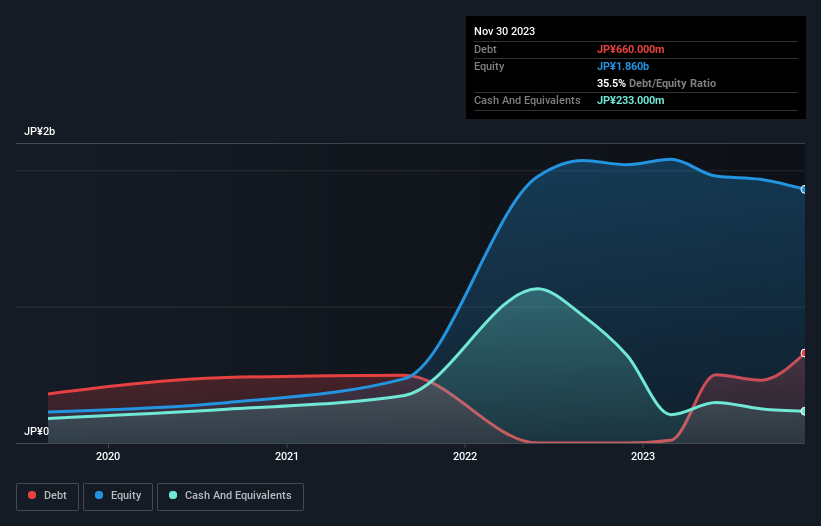- Japan
- /
- Electronic Equipment and Components
- /
- TSE:6522
We Think Asterisk (TSE:6522) Has A Fair Chunk Of Debt
Warren Buffett famously said, 'Volatility is far from synonymous with risk.' So it might be obvious that you need to consider debt, when you think about how risky any given stock is, because too much debt can sink a company. Importantly, Asterisk Inc. (TSE:6522) does carry debt. But is this debt a concern to shareholders?
Why Does Debt Bring Risk?
Generally speaking, debt only becomes a real problem when a company can't easily pay it off, either by raising capital or with its own cash flow. Ultimately, if the company can't fulfill its legal obligations to repay debt, shareholders could walk away with nothing. While that is not too common, we often do see indebted companies permanently diluting shareholders because lenders force them to raise capital at a distressed price. By replacing dilution, though, debt can be an extremely good tool for businesses that need capital to invest in growth at high rates of return. When we examine debt levels, we first consider both cash and debt levels, together.
See our latest analysis for Asterisk
What Is Asterisk's Net Debt?
You can click the graphic below for the historical numbers, but it shows that as of November 2023 Asterisk had JP¥660.0m of debt, an increase on none, over one year. However, it does have JP¥233.0m in cash offsetting this, leading to net debt of about JP¥427.0m.

A Look At Asterisk's Liabilities
Zooming in on the latest balance sheet data, we can see that Asterisk had liabilities of JP¥916.0m due within 12 months and liabilities of JP¥3.00m due beyond that. Offsetting these obligations, it had cash of JP¥233.0m as well as receivables valued at JP¥278.0m due within 12 months. So it has liabilities totalling JP¥408.0m more than its cash and near-term receivables, combined.
Given Asterisk has a market capitalization of JP¥4.98b, it's hard to believe these liabilities pose much threat. However, we do think it is worth keeping an eye on its balance sheet strength, as it may change over time. When analysing debt levels, the balance sheet is the obvious place to start. But you can't view debt in total isolation; since Asterisk will need earnings to service that debt. So when considering debt, it's definitely worth looking at the earnings trend. Click here for an interactive snapshot.
Over 12 months, Asterisk made a loss at the EBIT level, and saw its revenue drop to JP¥1.7b, which is a fall of 13%. That's not what we would hope to see.
Caveat Emptor
Not only did Asterisk's revenue slip over the last twelve months, but it also produced negative earnings before interest and tax (EBIT). To be specific the EBIT loss came in at JP¥260m. When we look at that and recall the liabilities on its balance sheet, relative to cash, it seems unwise to us for the company to have any debt. So we think its balance sheet is a little strained, though not beyond repair. Another cause for caution is that is bled JP¥1.1b in negative free cash flow over the last twelve months. So suffice it to say we consider the stock very risky. The balance sheet is clearly the area to focus on when you are analysing debt. However, not all investment risk resides within the balance sheet - far from it. For example Asterisk has 3 warning signs (and 2 which can't be ignored) we think you should know about.
Of course, if you're the type of investor who prefers buying stocks without the burden of debt, then don't hesitate to discover our exclusive list of net cash growth stocks, today.
New: Manage All Your Stock Portfolios in One Place
We've created the ultimate portfolio companion for stock investors, and it's free.
• Connect an unlimited number of Portfolios and see your total in one currency
• Be alerted to new Warning Signs or Risks via email or mobile
• Track the Fair Value of your stocks
Have feedback on this article? Concerned about the content? Get in touch with us directly. Alternatively, email editorial-team (at) simplywallst.com.
This article by Simply Wall St is general in nature. We provide commentary based on historical data and analyst forecasts only using an unbiased methodology and our articles are not intended to be financial advice. It does not constitute a recommendation to buy or sell any stock, and does not take account of your objectives, or your financial situation. We aim to bring you long-term focused analysis driven by fundamental data. Note that our analysis may not factor in the latest price-sensitive company announcements or qualitative material. Simply Wall St has no position in any stocks mentioned.
About TSE:6522
Flawless balance sheet and slightly overvalued.
Market Insights
Community Narratives



